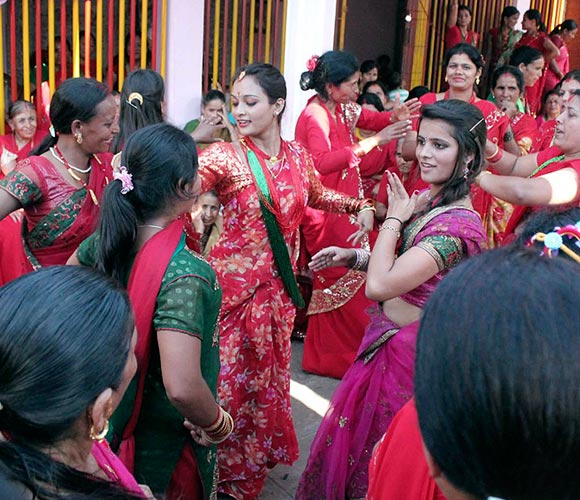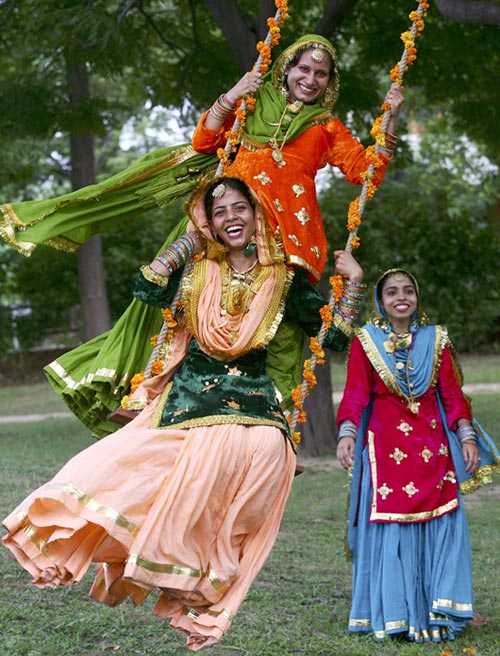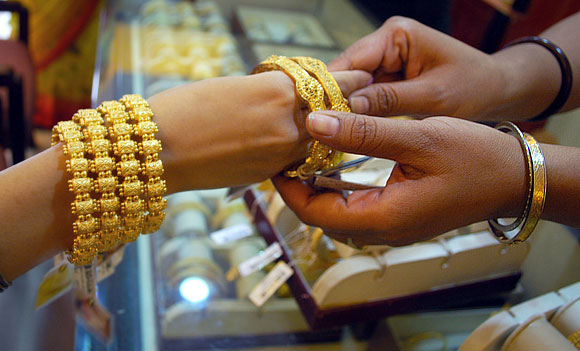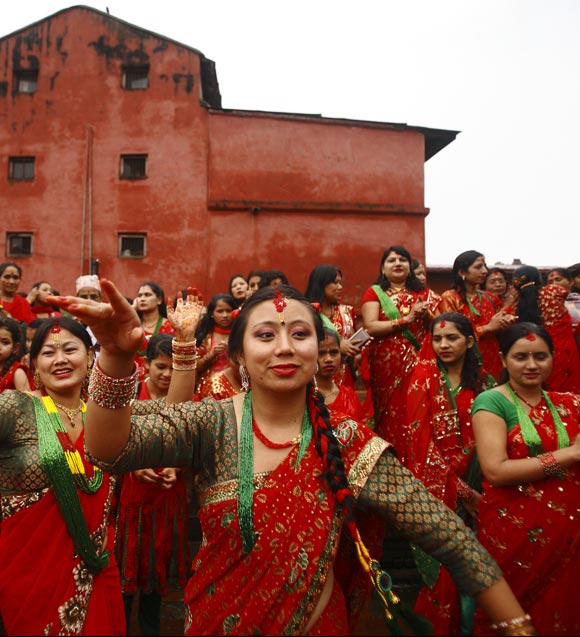
Dedicated to Goddess Parvati, the festival of Teej is celebrated differently in Nepal and in the various states of India. Here's a quick look at some of them:
The festival of Teej is dedicated to Goddess Parvati and celebrated across the north Indian states of Punjab, Haryana, Rajasthan, Uttar Pradesh and Bihar.
Teej falls on the third day after the new moon night in the month of Shravan and is celebrated in honour of the reunion of Lord Shiva and Goddess Parvati after a penance of a hundred years.
This three-day long celebration is marked by fasting and feasting. Hindu women pray for a happy wedded life and also the health and happiness of their husband and the children.
Here's how Teej is celebrated in different parts of India and in Nepal.
Rajasthan
During Teej, Jaipur witnesses the erections of flower-decorated swings from trees.
It is on these swings that the women folk sing songs celebrating the advent of monsoons. Their attire is predominantly green leheria sarees during this time.
While the married women receive gifts from their mothers, the unmarried receive gifts consisting of bangles henna, clothes and sweets from their future mother in law. Like in the other states, the married women here too, pray to Goddess Parvati for conjugal harmony.
A huge procession, starting from the city palace, of the Goddess (also called Teej Mata), called Teej Maata Ki Savari, is also taken out during this festival.
The palanquin of the Goddess is borne by eight men dressed in red colour. However, here, the Teej idol remains covered and instead the deity of Gangaur is opened up.
This procession consists of traditional palanquins, chariots, cannons being pulled by bullock carts, chariots, bands and dancers and even adorned elephants and horses. During this procession not only do folk artists enchant the crowd with their performances but many play musical instruments after dressing up like various Gods and Goddesses.
The prasad is also distributed among the crowd. The ghevar and malpua sweets are specially prepared during this time.
The Teej Fair or the Sawan Mela is also organized by the Rajasthan Tourism to showcase the various customs of the state.

Gujarat
Being the neighbouring state of Rajasthan, many of Gujarat's customs resembles that of the latter.
The most important aspect of this festival in Gujrat is the innumerable fairs where the women shop for their ornaments and various household embellishments.
This is the time for the married women to return to their parents' home for a few days.
A special sweet called seviyan is prepared during this time. The clothes worn by the ladies during this time is either lehengas in vibrant green, red or yellow with zari or gota work dupattas or red coloured saris with a front pallu. This festival witnesses a lot of garba and dandia dance performances by the young girls of the state.

Haryana
The Haryali Teej in this state is popular especially amongst the Ahirs and the Jats. The girls make designs on their hands and feet with mehendi and customarily receive new clothes from their parents.
For those who are married, the mother sends a gift, or a baya as it is called, to her daughter like during Karva Chauth. The baya contains food which is placed on a thaali.
This is then placed on a decorated chowk on which a picture or the deity of Goddess parvati has been placed. Once the prayers asking for the long life of the husbands is over, the evenings are devoted for merriment and songs.
This festival also sees an abundance of kites in the sky which the boys fly all day long.

Punjab
Other than the usual celebration of giving gifts to daughters and prayers to the Goddess, special celebrations are organized at the Rock Garden as well. Various parts of Punjab also witness Teej fairs called teelan where the women enjoy themselves adorned in their finest of clothes and jewellery. The main stalls here are those selling mehendi. Various schools also organize competitions for the young girls.
These range from rangoli and mehndi designing to singing and dancing. Beauty contests like Teej Qeen and Miss Teej are also organized.
The womenfolk in the villages of Punjab celebrate this festival by constructing decorated swings called peeng and performing gidda in dedication to their husbands. Songs like 'Aya Sawan Da Maheena Aa, Tun menu Rab Lagdha Naleh Naleh Makka Te Madina Aa' and 'Akh Mere Yaar Di Dukhe, Lali Merian Akhan De Wich Aiyee' are sung by the wives for their husbands.
Some of the Teej special dishes prepared by the ladies are gulgale, kheer and puri, karah and various pakodas.

Baniya community
Women celebrate this festival by gifting one another bindis and bangles. Also the married ladies who are celebrating their first Teej after marriage are necessarily given a piece of jewellery by their mother in law.
During this festival, the married daughters go to their mother's house and stay for around ten days and return only after Rakhi. During this time she is expected to carry sweets for her mother. Once she is back to her in laws house, she celebrates Buddhi Teej with them. This falls on the week post Rakhi.
However, unlike other communities where this festival is celebrated mainly by the married ladies, in this case is more of a celebration amongst the young girls. Not only are they bestowed with innumerable gifts, but a special lunch is also organised for them.

Nepal
In Nepal, Teej is observed for three days. The first day is called Dar Khane Din. On this day both the married and the unmarried women folk belonging to the Khas tribe, dress up in their finest of clothes. Then they assemble in one place to sing devotional songs and eat a sumptuous meal. This celebration continues till well past midnight and is accompanied by a lot of gaiety.
The second day stands for fasting. While some go without even a drop of water, some do have a fruit and then visit a Shiva mandir for offering prayers for the health and well being of the husbands.
An oil lamp is lit during this time which needs to remain so throughout the night. During this time, the Pashupatinath temple dedicated to Lord Shiva sees the maximum crowd.
On the last day, the women bathe in the red coloured mud found on roots of the holy datiwan bush. This is done for three hours post which they sit in semicircle while a priest chants various devotional prayers. This symbolizes the washing away of all their sins. This is known as the festival of Rishi Panchami.
All in all, no matter where, this is a festival of colours and gifts; of swings and fairs; of husbands and wives; of love and health. Wishing all you ladies and girls out there, a
Very Happy Teej.